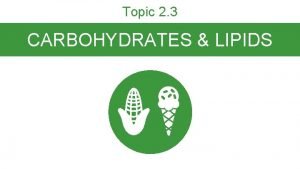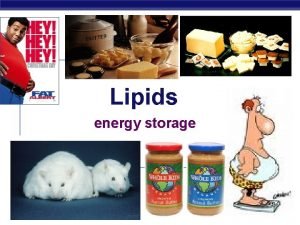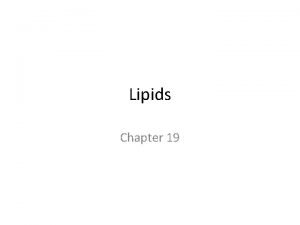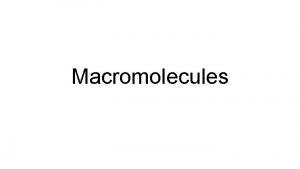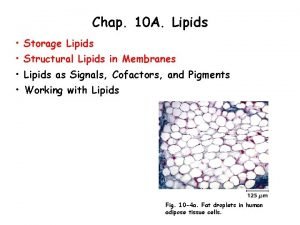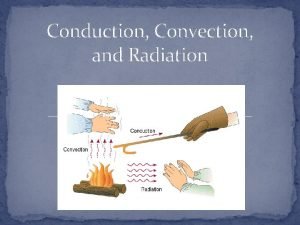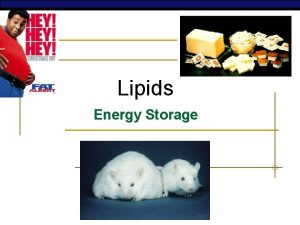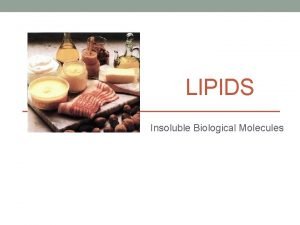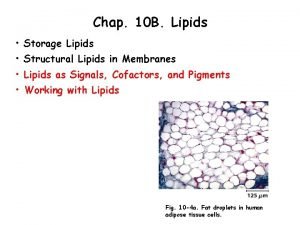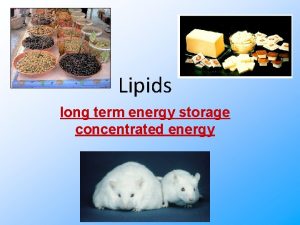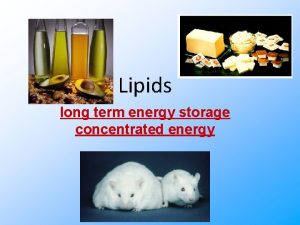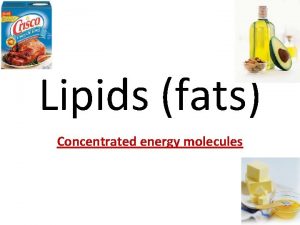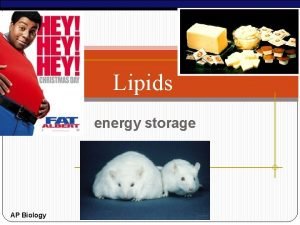Lipids q Function of Lipids Energy storage molecules











- Slides: 11

Lipids q Function of Lipids ü Energy storage molecules in animals [release 9 kcal/g versus 4 kcal/g by carbohydrates] ü Form membranes (cellular or sub-cellular) that separate compartments in cells [lipids are insoluble in water so help generate membranes] ü Serve as chemical messengers [steroid hormones are primary messengers, while prostaglandins and thromboxanes are secondary messengers mediating hormonal response] MEDC 527 Fall 2008 1

Lipids q Classification of Lipids by Structure ü Lipids can be classified into four groups based on their structure 1) Simple lipids, e. g. , fats; 2) Complex lipids 3) Steroids; 4) Prostaglandins, thromboxanes, and leukotrienes Simple and Complex Lipids Complex Simple Phospholipids Fatty acid PO 4 Alcohol MEDC 527 Fall 2008 Fatty acid PO 4 choline Sphingosine Fatty acid Sphingolipids Sphingosine Fatty acid Glycerol Glycerophospholipids Glycolipids Glup / Galp Fatty acid 2

Lipids q Triglycerides ü ü Animal fats and vegetable oils are triglycerides Triesters of glycerol and long chain carboxylic acids called fatty acids Glycerol component cannot vary, but the fatty acid component may vary Fatty acids are unbranched carboxylic acids having 10 to 20 carbons in even number ü Some fatty acids have double bond(s). Typically these double bond(s) are cis n A triglyceride p + Glycerol m palmitate (16: 0) oleate (18: 1) stearate (18: 0) MEDC 527 Fall 2008 3

Properties of Triglycerides ü Generally fats from animals are solids at room temperature. Most fats from plants and fish are liquids. Liquid fats are referred to as oils. ü Presence or absence of unsaturation makes a triglyceride solid or liquid Saturated and trans fatty acids stack well (greater hydrophobic interactions; greater order in arrangement; carries over to triglyceride structure) Unsaturated cis fatty acids do not …. (lesser hydrophobic interactions; lesser order in arrangement; carries over to triglyceride structure) MEDC 527 Fall 2008 4

Properties of Triglycerides Saturated Fatty Acids 12: 0 CH 3(CH 2)10 COOH 14: 0 CH 3(CH 2)12 COOH 16: 0 CH 3(CH 2)14 COOH 18: 0 CH 3(CH 2)16 COOH 20: 0 CH 3(CH 2)18 COOH lauric acid myristic acid palmitic acid stearic acid arachidic acid Unsaturated cis Fatty Acids 16: 1 CH 3(CH 2)5 CH=CH(CH 2)7 COOH 18: 1 CH 3(CH 2)7 CH=CH(CH 2)7 COOH 18: 2 CH 3(CH 2)4 (CH=CHCH 2)2(CH 2)6 COOH 18: 3 CH 3 CH 2(CH=CHCH 2)3(CH 2)6 COOH 20: 4 CH 3(CH 2)4 (CH=CHCH 2)4(CH 2)2 COOH palmitoleic acid linoleic acid linolenic acid arachidonic acid MEDC 527 Fall 2008 Tm (OC) 44 58 63 70 77 1 16 -5 -11 -49 5

Properties of Triglycerides ü Pure fats and oils are colorless, odorless and tasteless. ü Fats are not soluble in water. They are hydrophobic molecules and soluble in organic solvents ü The presence of double bonds, especially in plant fats, makes them susceptible to oxidation. Heavily oxidized fats are not edible. These generate rancidity. ü The ester group in fats is susceptible to hydrolysis releasing acidic groups, e. g. , butyric acid, which have bad taste and odor. _ Na. OH + _ _ + + Mixture of fatty acid sodium salt (Soap) Saponification MEDC 527 Fall 2008 6 +

Complex Lipids ü Complex lipids constitute the main component of membranes. ü Two main types of complex lipids – phospholipids and glycolipids. Phospholipids contain a phosphate group, while glycolipids contain a carbohydrate group ü Phospholipids can be made from glycerol or from sphingosine + choline _ Phosphatidylcholine (lecithin) (A glycerophospholipid) A sphingomyelin (A sphingolipid) sphingosine + + choline _ MEDC 527 Fall 2008 7

Membranes ü Complex lipids containing unsaturated fatty acids constitute cell membranes. ü Membranes are made up of lipid bi-layers. The Fluid Mosaic Model of Cell Membranes MEDC 527 Fall 2008 8

Steroids ü Steroids constitute third major class of lipids ü Steroids are cyclopentanoperhydrophenanthrenes. ü Cholesterol is the commonest steroid. It is present cell membranes. It is also present in lipoprotein particles, e. g. , LDL, HDL, and others C A B D Cyclopentanoperhydrophenanthrene (Steroid skeleton) Cholesterol MEDC 527 Fall 2008 9

Lipoprotein Particles ü Lipoprotein particles transport cholesterol in blood ü Contain a core of hydrophobic lipid molecules surrounded by a shell of hydrophilic molecules such as proteins and phospholipids ü At least four kinds of particles: HDL, LDL, VLDL and Chylomicrons Apolipoprotein Cholesterol Phospholipids Cholesterol ester A Model of a Lipoprotein Particle MEDC 527 Fall 2008 10

Prostaglandins, Thromboxanes and Leukotrienes ü Prostaglandins are derived from arachidonic acid ü They have a wide variety of effects of the body; they can lower or raise blood pressure, cause inflammation, induce blood clotting and induce labor ü Aspirin and other NSAIDs inhibit the enzyme (cyclooxygenase COX) involved in the synthesis of prostaglandins Arachidonic Acid PGE 2 Thromboxane A 2 PGF 2 a Leukotriene B 4 MEDC 527 Fall 2008 11
 Cellulose amylose amylopectin and glycogen
Cellulose amylose amylopectin and glycogen Are lipids energy storage
Are lipids energy storage Examples of lipids
Examples of lipids Classification of lipids flowchart
Classification of lipids flowchart Macromolecule
Macromolecule Organic molecules vs inorganic molecules
Organic molecules vs inorganic molecules Storage lipid structure
Storage lipid structure Radiation examples
Radiation examples Kinetic energy of gas molecules
Kinetic energy of gas molecules Primary storage and secondary storage
Primary storage and secondary storage Primary storage and secondary storage
Primary storage and secondary storage Uses rigid metallic platters
Uses rigid metallic platters
